The church names the brothers St. Cyril and St. Methodius as “Slovenian teachers”, i.e. Slavic teachers, and “Apostles to the Slavs,” as they brought Christian enlightenment to the Slavic peoples in their native language. Today, opening a book or reading a text from an electronic device in Cyrillic script (named after St. Cyril), we thank these saints for the opportunity to learn numerous professions or simply for being educated people.
Cyril and Methodius (before monasticism, respectively, Constantine and Michael) came from the city of Thessaloniki in Macedonia, from a noble family. Their family was large, with Methodius being the oldest child (825-885), and Cyril was two years younger (827-869). Communion with God through prayer and spiritual education became a necessity for them since their youth. Therefore, it was not accidental that Methodius, and after him Cyril, left secular life and became monks on Mount Mysian Olympus (or Bithynian Olympus, Turkish: Uludag; Tr.), not far from Constantinople.
The youngest of the brothers, Cyril, was considered one of the most educated people of his time. The brothers did not stay in the monastery for a long time – they were often sent for and called upon numerous responsible missions. One of the missions was the preaching of the Gospel among the Khazars, to which the brothers went at the request of the Byzantine emperor in 860. On the way to their mission, the brothers passed Chersonesus of Taurica (modern Sevastopol in Crimea; Tr.), where they found the relics of the holy martyr Clement of Rome (who was banished to Chersonesus together with other prisoners during the reign of the Roman emperor Trajan in the 4th century; Tr.). Also in Chersonesus they found the Gospel and the Psalter written in “Russian letters”, and at the same time a man who spoke Russian taught them his language.
In 863, at the request of Prince Rostislav, the holy brothers went to Moravia (a historical region in the Czech Republic), where it was necessary to preach the Word of God in Slavic. This activity was met by German bishops with opposition and condemnation, as they considered only Latin, Jewish and Greek to be acceptable church languages. Cyril and Methodius retorted that in the Gospel the Lord Himself says, “Therefore, go and teach all the nations …”
With prayers and fasting, the two brothers- enlighteners took on this difficult and responsible mission. They compiled the Slavic alphabet and translated the Gospel and liturgical books.
The opposition from the side of the Western bishops persisted. In response, Sts. Cyril and Methodius brought to Rome part of the relics of St. Clement (which they found in Crimea; Tr.). This way they wanted to ensure the support of the Roman bishop. Pope Adrian blessed the two brothers-missionaries, and their preaching and worship in the Slavic language. During that trip to Rome, St. Methodius was ordained a bishop.
After the death of the brothers (St. Cyril died in 869, and St. Methodius in 885), their opponents managed to temporarily ban the writing in Slavic in Moravia. Some of the students were executed, some moved south, to the lands of Bulgaria (particularly, Gorazd and Clement of Ohrid) and Croatia. Thanks to the students, the alphabet created by the Saints spread to Bulgaria and Croatia, and then to Serbia and Russia. It is interesting that in some areas of Croatia back in the 20th century it was possible to meet the service of the liturgy of the Latin rite in the Slavic language.
The wide-spread veneration of Sts. Cyril and Methodius among the Slavic peoples began in the 19th century, when the names of the saints became a symbol of self-determination of the cultures in the Slavic countries. In 1858, the Memory Day of the Enlighteners of the Slavs (May 11/24) was celebrated for the first time in the Bulgarian city of Plovdiv. Nowadays, this day is a great holiday of Slavic writing and enlightenment in a number of Slavic countries, in particular, Russia, Ukraine, Belarus, Bulgaria, Serbia. In the Czech Republic, Slovakia and Northern Macedonia this holiday is celebrated on the other dates. It is notable, that the largest Sts. Cyril and Methodius Cathedral is located in the city of Khust in Carpathian Russia, nowadays Transcarpathian region of Ukraine. This is the cathedral of the Khust-Vinogradovsk Diocese of the Ukrainian Orthodox Church, built in the 1990-2000s. It holds more than 3,000 parishioners. It’s worth mentioning that the main part of the church was built under the direction of Archpriest Alexander Belya

